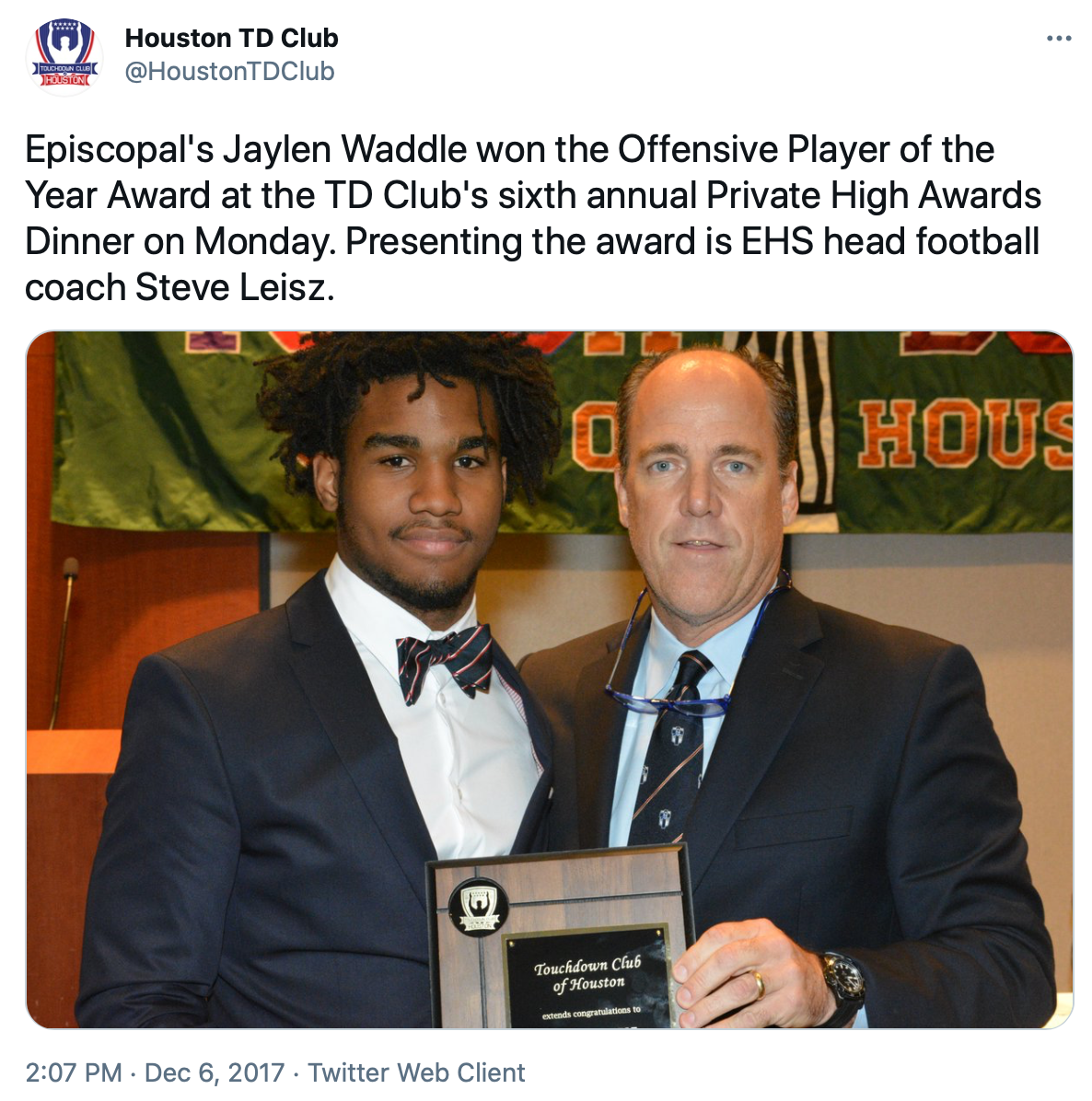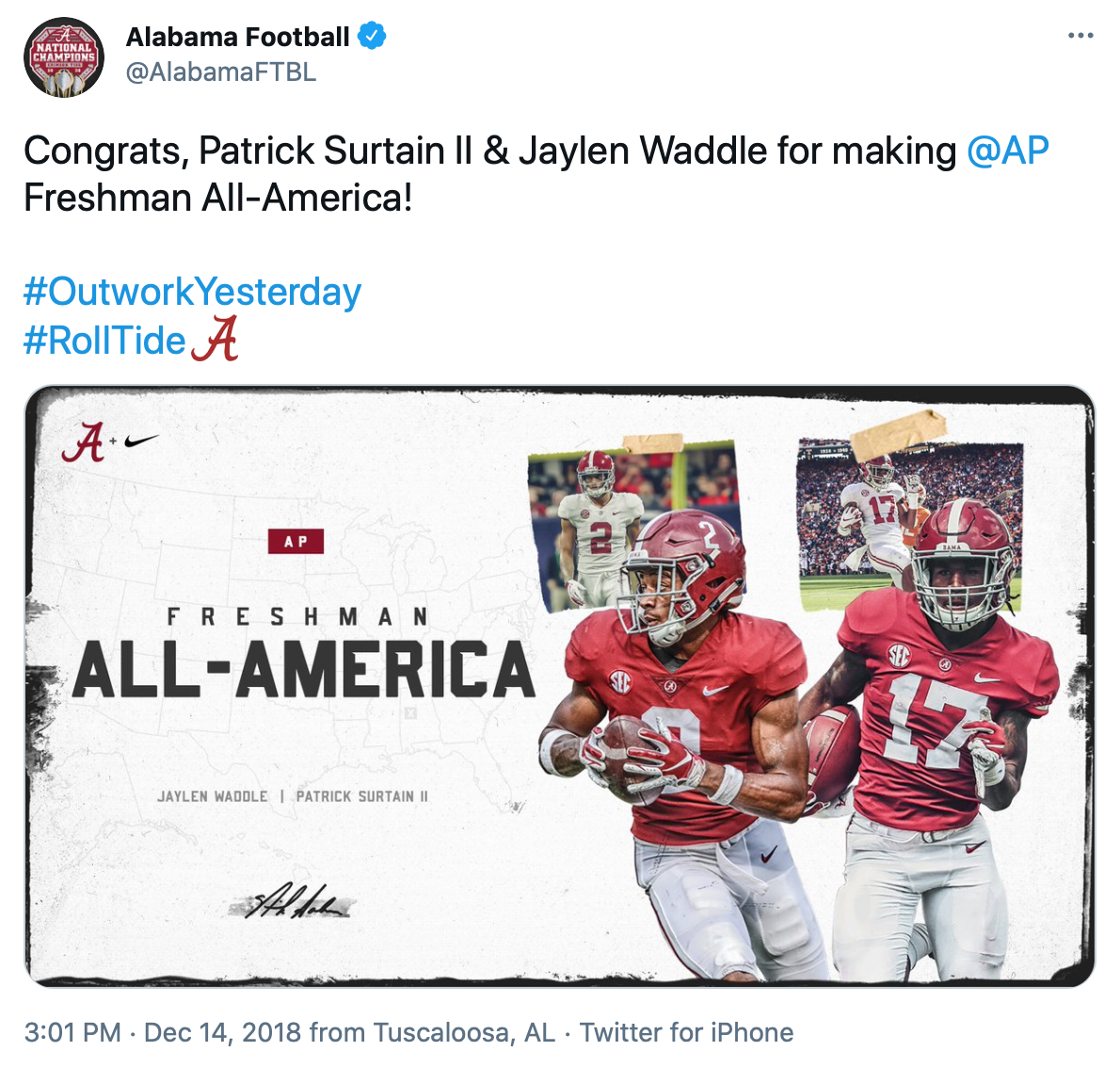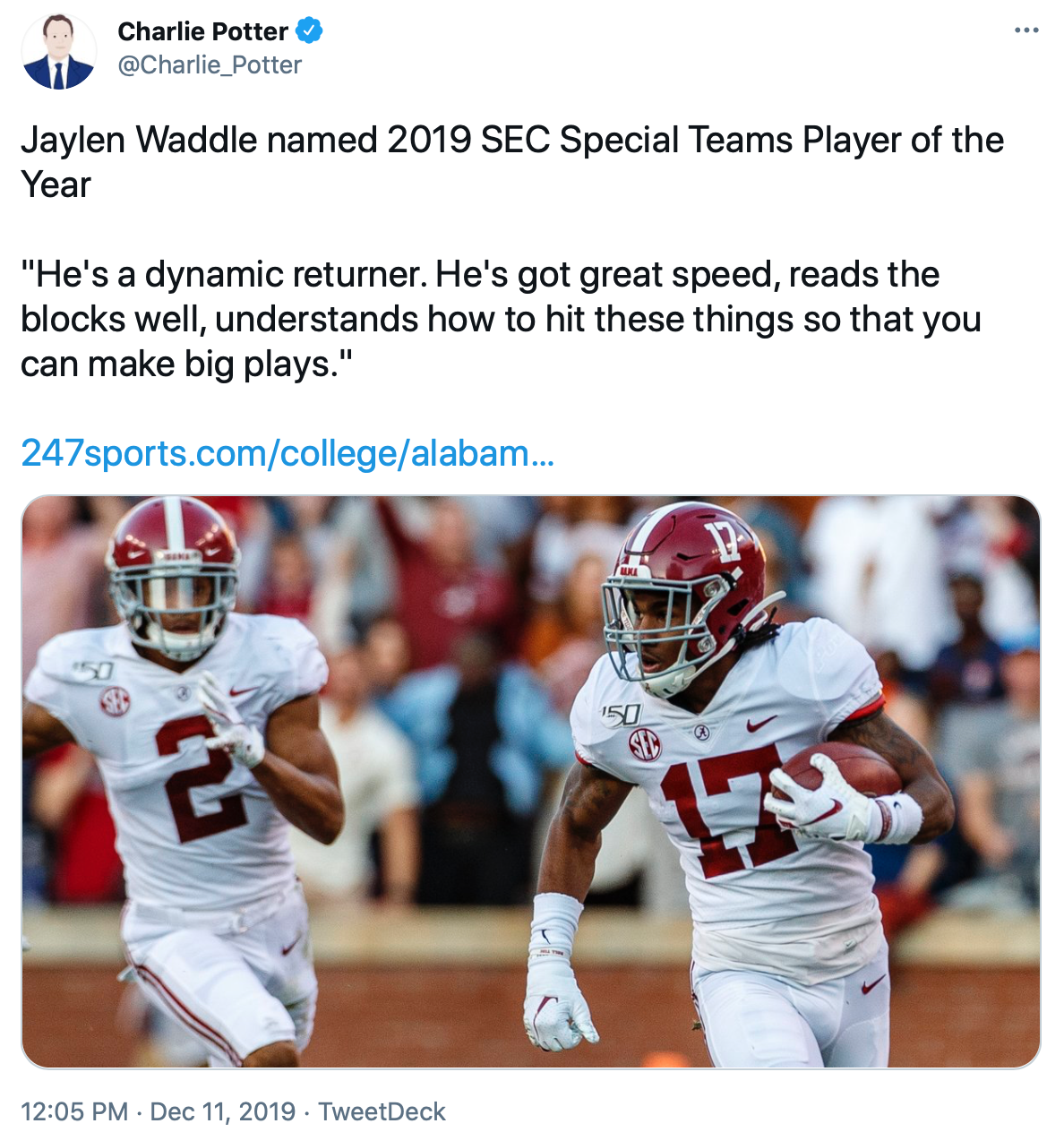Jaylen Waddle
WR | Alabama Crimson Tide | 5-9 1/2 | 180 lbs.
Rookie Expectations
Over the last three NFL seasons, wide receivers who predominantly lined up on the outside have run five particular routes for about 75% of total routes. Those five routes are Gos, Hitches, Outs, Slants, and Crossers. For WRs playing from the slot, these five routes are also featured, at slightly altered percentages, for a nearly identical combined total. The final 25% will be distributed among Ins, Posts, Corners, some Screens, and the rest on exotic combo routes when split wide. For slot WRs, the majority of that 25% will go toward Screens and shallow work in the flat. Whenever I make references to “NFL routes” in these Dyno rookie profiles, those are the guidelines I am following.
The Story
We have arrived, it is finally draft day.
To that end, you’ll hear your share of old idioms tossed around over the next few days. One common idiom that might not have applied to the draft until now: “You can lead a horse to water, but you can't make him drink.”
Fact: horses need five to 10 gallons of fresh water every day, so it is actually quite common for horse owners being very concerned their prized quadrupeds are drinking enough water. But, no matter how hard one may try, one simply cannot force these 2,000-pound mammals to drink.
For our purposes, Jaylen Waddle is the water. When Waddle was playing for Bellaire Episcopal, HC Steve Leisz did his rounds advertising his explosive WR — he was begging coaches to take a drink. He was met with the all-too-common “he’s too small” opinions.
First they ignore you, then they laugh at you, then they fight you, then you win. The game has changed. For some cold, hard data in support, head on over to the profile of Justin Fields. I’m just going to rip the bandage off quickly. The prototypical mold for several positions in the NFL haven’t just changed, those molds have already been recalled, reprocessed, and remanufactured. That said, as of the 2020 season, only two-thirds of the league are fielding a 21st-century offense. No longer derided as “gimmicks,” these Air Raid-esque offenses have found a home paired alongside actual defenses. And the last two seasons have ended with Super Bowl victories for teams utilizing three-or-more WR packages at top-10 league rates.
Never look a gift horse in the mouth. Whether you refer to it as the spread, 11-personnel, or “Posse” personnel, the game has changed, and scoring is on the rise. Why? The available crop of cornerback talent just can’t keep up. Five of the six highest scoring seasons in NFL history have come in five of the last six seasons. The results from the ‘20 season paint the perfect picture. NFL teams average a historical record 24.8 PPG. It also set the record for the most receiving TDs/game at 1.70. And, with defenses scrambling to field enough defensive backs to cover opposing WRs, ground games averaged greater than 1 one TD/game (1.04) for the first time in over 40 years. But these changes date back a couple seasons after Hal Mumme and Mike Leach put their heads together to create the Air Raid. Over the last eight seasons, offenses averaged greater than 1.50 receiving TDs per game seven times. You need to go back 56 years, prior to the NFL-AFL merger, to find the last example.
A bad excuse is better than none. Some will say that COVID-19 is the culprit, others will reference the rule adjustments to protect QBs and receivers. I tend to agree with both. But the rule changes were long overdue in terms of protecting players, even though it makes playing cornerback extremely difficult.
Which brings us to the ideology that WRs need to be a certain height in order to be considered as a high NFL draft target. (By the way, early on in the recruiting process, Waddle wasn’t even drawing Power Five interest, to show how things have changed in recent years.)
Don’t throw the baby out with the bathwater. The Tweet above should open some eyes. Most WRs need elite athleticism to even receive the attention of NFL teams during the draft. And all WRs need to pair that athleticism with elite college results to be selected high enough in the draft to be guaranteed an active roster spot on Day 1. Take note to the fact that “over 6-feet” is specifically mentioned for the conversion to cornerback. The NFL desperately needs secondary help. It’s the result of most individuals with the athleticism to match reliable hands sticking at WR. And that completes our WR formula: elite athleticism + elite results + reliable hands. Short of an absurd ability to diagnose coverages, nothing else matters for pre-NFL stock — that is, in relation to on-the-field expectations.
The bee's knees. Too many analysts still use Antonio Brown as the go-to when making the case for a sub six-foot wideout. The dude was drafted a decade ago, a full three seasons before targeting became a penalty… in college football! We can do better and we have a long list of examples. In fact, the average NFL WR height last season was only 72.4 inches, just a hair over six-feet. The alpha is, of course, Tyreek Hill. Then we have Diontae Johnson, Curtis Samuel, Deebo Samuel, Brandon Aiyuk, Christian Kirk, Jamison Crowder, Marquise Brown, Brandin Cooks, Tyler Lockett, Odell Beckham Jr. (of course), and both Stefon Diggs and D.J. Moore measured out at exactly 72 inches.
Well begun is half done. It comes as zero surprise that each of the bottom-nine 2020 passing offenses are currently in the market for a QB. But does it come as a surprise that seven of the QB-needy franchises fall inside the top-15 teams utilizing the most Heavy or “Ace” personnel last season? Only four teams (Broncos, Washington, Jaguars, and Jets) utilizing three-or-more WR sets at a top-15 rate are searching for a QB. We are left needing answers to real question:
- Are the QB-deficient teams using such a high rate of Heavy personnel grouping to counteract shortcomings at QB?
- Is it actually the dearth of WRs fitting the elite athleticism + elite college production + reliable hands-mold that has prevented these offenses from stepping forward in time?
No matter the answers, the NFL is desperate for QB talent. But nearly every team is also frantically searching for elite WRs, and the CBs good enough to defend them.
Make hay while the sun shines. A total of 13 WRs were selected in the first two rounds of the 2020 NFL Draft, which will be at minimum tested in 2021. And we may even see up to eight WRs drafted in the first round. Guess what? The only one measuring over 6-foot-0.5 inches is Terrace Marshall Jr. Some rumors are suggesting a dark horse QB will slip into the back-end of the first. Add those six QBs, eight WRs to the five CBs likely going in the first, and just under two-thirds of the entire first round would be dedicated to three positions.
The Attributes
Imagine sending your child that’s being coached at cornerback to defend a middle school squad featuring Waddle and Texas WR Brennan Eagles. That was precisely the case for schools opposing Waddle’s Houston, Texas middle school. It shouldn’t surprise anyone that they never lost a game. As you may have noticed, ‘The Story’ on Waddle above was entirely replaced by a narrative looking to displace misplaced beliefs on Waddle’s size, size in general.
Like Elijah Moore, Waddle’s personal life is a complete mystery. His available interview, press conference history provided nothing other than his sister being a fan of the New York Giants. Then we have the mystery that is his Bellaire Episcopal HS career. Either during his junior or senior year with the Knights, Waddle collected 48 receptions, 1,382 yards, and 26 TDs. Either during his sophomore or junior seasons, he brought down 40 balls, 772 yards, and 10 TD. What we do know is that, like most, he didn't do much in ninth grade — sans scoring on a kickoff return on his very first touch in the playoffs. So, if the 1,382 yards came in 12th grade, why didn’t he play as a sophomore? If those were actually his junior year results, what numbers did he generate as a senior?
Since I want to get this profile published in time for the draft, I have not researched either his junior or senior highlight reels from his personal Hudl page to track down the answers. Moving on to his athletic profile, Waddle did not work out at either of Alabama’s Pro Days. (Here is the link to his Pro Day interview).
That leaves us with his prep combine testing at The Opening. Waddle ran a 4.51-second 40-yard dash (57th percentile compared to NFL Combine WRs over the last seven seasons), 4.12-second Pro Shuttle (63rd), and 37-inch Vertical Jump (53rd). But 247Sports verified that “J-Dubb” ran a 4.37-second 40-time (78th percentile) at a Houston camp back in 2018. And, the following year, Waddle and Henry Ruggs III — owner of the fourth-fastest NFL Combine 40-time (4.27s) since the inclusion of electronic timing in 1999 — finished neck-and-neck in a race. Had Waddle been able to test at his Pro Day, there would be zero question who the WR2 in this class would be.
“Magic” entered with the Class of 2018 as a consensus four-star prospect once teams got over his size. ESPN listed him as its WR12, 247Sports had him as its WR5, and Rivals considered him as the WR7. He collected 25 Power Five scholarship offers, with five schools (Alabama, Florida State, Oregon, TCU, and Texas A&M) making official visits to seduce Waddle into their program. The recruiting work from former DC/current Jaguars DL coach Tosh Lupoi and former OC/current Maryland HC Mike Locksley hooked Waddle’s path to Tuscaloosa. Jaylen’s very first game for the Crimson Tide opposite Louisville resulted in 143 all-purpose yards. He ended that season as the SEC Freshman of the Year. He took home the SEC Special Teams Player of the Year after his true sophomore season. Despite the insane per-route production, his overall numbers from both of those seasons were capped playing behind Jerry Jeudy, Ruggs, and DeVonta Smith.
Waddle finally had a chance at a featured role last season. Even with Smith returning to Bama, it was Waddle who emerged as the WR1 for Mac Jones during the first four games. It all came to close when Waddle snapped his ankle on the opening kickoff at Tennessee in Week 8. While he made a return in the CFP Championship against Ohio State, it was more painful watching Waddle limp around the field while playing hurt than anything he was able to accomplish. It lends to the question: would Waddle have been able to participate at his Pro Day had he allowed the ankle to properly heal?
True Freshman Season (2018)
W1 vs. Louisville | W5 vs. Louisiana | W8 at Tennessee | W10 at LSU | W13 vs. Auburn | SEC CC vs. Georgia | Highlight Reel
(Quick note: the easiest way to view these games from YouTube — while also avoiding the ads — is to download the files using a YouTube Downloader. My recommended media players are QuickTime (Mac) or VLC).
As is always the case, I’ve provided links to freely available film consisting of game play well in excess of what will be covered in this profile. For his first two Bama seasons, I’ll be using the full games from the list of provided links. For his true junior season, the highlight reel covers just about every important play, so we’ll use that link. In addition, since I’ll be working a bit more quickly through Waddle’s important plays, you’ll have three options to follow along:
- Just follow along as I go through each full-game file for his freshman and sophomore season, and the highlight reel of Waddle’s junior season.
- I’ll include the exact video timer locations from both the full-game files and highlight reels. You will have the option to follow using both sources.
- I will only be looking at more than three plays from two games using Waddle’s 2018 or 2019 tape. So, you can also choose to just skip ahead to the analysis from his 2020 season, where we’ll see his most involvement.
No matter which approach you use, I do recommend that you watch each of the highlight reels. They include the majority of Waddle’s explosive special teams returns from his career. We’ll begin with three plays from the Louisville game from Week 1. Our first look at Waddle is at 32:40 (not included in the highlight reel). It’s a simple Bubble screen to the flat where Jaylen — No. 17 Jersey — collects nine yards beyond the catch point. Flat work will be essential during his future when stationed in the slot. The Cardinals are showing Cover 4, but bring the strong safety forward to reveal it is Cover 3. With UofL again calling in a Cover 3 at 48:12 (HL 0:52), where we get to see that outstanding speed blaze a trail past LCB Rodjay Burns to make the fingertip catch for 49 yards. Disregard the commentator’s attempt to put the blame on FS Dee Smith. It’s all on Burns to defend his third of the deep zone. We’ll close out the game with the play at 2:16:57 (not included in the highlight reel). It’s another designed Bubble Screen, giving us a glimpse at Waddle’s impressive footwork in avoiding SS TreSean Smith.
On to the Louisiana game from Week 5, the only non-Power Five opponent I’ll include. At the 10:54 mark (HL 1:58), it’s the intention of dime CB Corey Turner to funnel Waddle away from the middle of the field (MOF) toward the boundary safety. The Ragin' Cajuns are in a Cover 2-Man shell where the MOF is intentionally left open. As you can see, Waddle’s speed is beyond Turner’s abilities. He pays the price. At 17:02 (HL 2:36), the score is out of hand, and Louisiana falls into a Cover 4. It’s Terik Miller’s turn to taste the speed of Waddle. Let’s close with the Alabama record for the longest TD reception in its history at 23:50 (HL 1:15). As we’ve already seen, Waddle is a threat to take it the distance using his elite speed on every play. But he’s no one-trick pony. Miller is the Conflict Defender on the RPO. When he spills down toward the mesh point with Brian Robinson Jr., it’s on FS Blair Brooks to pick up Waddle. Bye-bye!
Collecting 138 yards, two TDs outside the Power Five is not all that unexpected. But Waddle shows us he’s more than capable of doing the same in SEC play at Tennessee. The first play is at 5:32 in the footage (not included in the highlight reel). Pause the Whip-Out route at 5:42, hit play, and watch that one-step acceleration! Go to the 19:25 mark (HL 2:23) for the start of the play, but you’ll need to look at the replay beginning at 19:58 to see how he actually pulls this off. The Vols are in Cover 4. Fault may appear to be on FS Nigel Warrior, but it’s LCB Bryce Thompson who fails to get depth after biting on Play Action. But that speed is breathtaking, independent of blame. Our final play is at 1:25:33 (not included in the highlight reel), but best viewed on the replay at 1:25:45. Watch how nickel corner Baylen Buchanan does everything he can to keep Waddle from that unattended MOF in the Cover 6. Not much else he can do.
Jumping to the LSU game from Week 10. It’s not an explosive play, defended by Man (Cover 1), but the Out at 7:29 (not included in the highlight reel) shows us the respect Waddle is already commanding. Safety Todd Harris Jr. is giving Waddle a massive cushion, handing out easy yardage. The last play I wanted to highlight is not shown in this film. We need to use the highlight reel (2:28) to check it out. The Tigers show blitz, but end up only sending four, and dropping into Cover 6. It’s a pinpoint throw on the Back-Shoulder Go from Tua Tagovailoa. It’s a nearly indefensible play for LCB Kristian Fulton considering the combination of ball location and footwork from Waddle.
Jumping to the Iron Bowl, we’ll begin with the play at 47:53 (not included in the highlight reel). It’s a great example of Waddle working with his pressured QB on the Scramble Drill. The diving snag is just the icing. At the 1:46:49 mark (also not included in the highlight reel), a quick Bubble to Waddle goes 10 yards without defender contact due to that speed. Let’s close the game at 1:55:41 (HL 0:23). Both Noah Igbinoghene and Daniel Thomas must not have received the memo on Waddle’s speed. Wow!
The final game we’ll view from 2018 will be the SEC Championship facing Georgia. The first example is found at 1:39:23 (HL 2:13). Waddle just makes it look too easy, slipping into the MOF of the Cover 4. It’s an all-day result when achieved. LB Juwan Taylor failed to get the depth to aid his safeties. At the 1:47:43 mark (HL 3:59), Waddle puts Tyrique McGhee’s man coverage in his rearview with that otherworldly athleticism. Jumping to 2:10:12 in the footage (HL 0:34), Waddle provides Tua with another way to escape the pressure for a 23-yard gain. Not much McGhee can do in that situation. The final play is at 2:26:05 (HL 3:05). Nothing exceptional, but an important NFL route, and in a massively clutch situation.
True Sophomore Season (2019)
W1 vs. Duke | W7 at Texas A&M | W14 at Auburn | Highlight Reel
Waddle’s second season in Tuscaloosa was an up-and-down affair with Tagovailoa under center. When Jones took over after Tua’s hip injury, Waddle finished strong. Let’s begin with Waddle’s best game working with Tagovailoa, Week 1 vs. Duke. Jump ahead to the 8:50 mark in the video (not included in the highlight reel). The Blue Devils just don’t know how close they came to seeing Waddle take this one 94 yards on the Slant. You simply cannot miss tackles on this guy. They can thank LB Koby Quansah for preventing disaster. More proof showing the dangers of not wrapping Waddle up is shown at 28:10 (also not included in the highlight reel). It’s a simple screen with mediocre blocking, but Waddle turns it into 44 yards beyond the catch point. Marquis Waters wants more proof, so Waddle is happy to abide with 14 yards after first contact at 58:39 (missing from highlight reel).
We finally see someone (Leonard Johnson) properly defend Waddle at 1:03:49 (not on HL reel). At 1:13:37 (HL 0:21), we begin to see these recurring Cover 2/Cover 4 results are not simply pure luck. It usually requires multiple seasons for WRs entering the NFL to grasp an understanding on attacking these zones in the MOF. Some just never get it. And he’s not just attacking over the top of the LBs, he’s turning his routes in just under the safeties. It’s subtle, but truly exceptional work from a 20-year-old. Our final example from the game is found at 1:17:17 (not in the highlight reel). However, this is a bit different. It’s a screen block set for Jeudy. By the time Michael Carter II comes free of his block, the TD has already been scored.
The last game we’ll check out from his true sophomore campaign is the Auburn game (Iron Bowl) from Week 14. Each of the plays we’ll view will see the Tigers in Man. We’ll begin at 10:14 in the video (HL 5:23). As we already know, Waddle can turn any catch into six points. It’s a simple Hitch where Christian Tutt is just not fast enough to keep him out of the paint. Moving on to 16:49 (HL 5:46), Waddle’s future NFL team is no doubt in love with this play. Look at that explosion off the line! Waddle has already turned the Out into points before Tutt can even get a hand on him. Our final example is shown at 19:05 in the video (HL 6:01). What are we missing from Waddle’s arsenal repertoire? A high-point example. This ball from Jones is late, quite underthrown — one of a collection of examples. Waddle is forced to surrender his two yards of separation Javaris Davis, but uses that insane vert to bring it home.
True Junior Season (2020)
W4 at Missouri | W5 vs. Texas A&M | W6 at Ole Miss | W7 vs. Georgia | Highlight Reel
The only thing missing from Waddle’s 2020 highlight reel is his involvement in the title game. Considering the amount of limping we’ll avoid, it’s not a terrible loss. All four games are provided, in sequence, to provide everything you need to evaluate Waddle’s season. With that in mind, I’ll provide you with a general direction to set up each play. However, you can be rest assured that I’ve already watched, analyzed each of these games in depth. One of Waddle’s favorite patterns is the Crossing route. We are offered a slew of examples that can be found at 0:29, 2:21, 2:55, 4:17, 4:42, and 5:41. During his Tide career, Waddle turned 7% of total routes into 18% of yardage — 7.18 yards/route run (YPRR) — on Crossers.
Let’s turn our attention to the different coverage shells. His future QB will be able to hit the easy button when he catches the opposing defense in Man on Waddle. You get three additional examples at 0:00, 0:49, and 6:12. Waddle scored 8-of-17 career TDs (47%) on only 29% of career routes when defended in a one-on-one. When opposing defenses close off the MOF in Cover 3, the scheme easily stands as the most challenging for Waddle. You can find examples at 1:18, 2:30, 3:12, and 4:52. However, Waddle at his very worst will still return an exceptional 3.00 YPRR. Yeah, I know.
As we already know, Waddle is a dangerous man when the MOF is open. You can see the path strewn with Cover 4 victims at 3:21, 5:25, and 6:28. You may want to take a seat for this next sentence, you may get light-headed. When Waddle faced Cover 4 during his career on 16% of routes, he collected 25% of receptions, 33% of yards, 41% of TDs, and a resulting 6.61 YPRR. Those are not typos. The final play you simply must view comes to us from the Missouri game (1:47). The Tigers threw everything they had at Waddle. Including double-covering the explosive stud. It didn’t work. At least they can say they tried.
Fantasy Fit
The very simple answer is every team in the market for a WR missing out on Ja’Marr Chase. But pretty much every NFL team will take a long look at Waddle after the five elite QB options, Chase, and Kyle Pitts are off the board. Optimal landing spots include, but are not limited to: Miami, Detroit, Philadelphia, and Carolina. It will all come down to how a team views Waddle. If he is only viewed as an option from the slot, we can essentially eliminate Minnesota, Cleveland, Tennessee, Las Vegas, San Francisco, and NY Giants — the teams who passed the least using Spread personnel.
Not so fast. Waddle has every bit of what it takes to work on the outside. And modern NFL offenses use so many alignment variations that you’ll see nearly every single receiver in the game running a number of their routes from the slot. With that in mind, you can take it to the bank that his future NFL team will envision a role for Waddle that aligns him all over their formation. So, the potential options for his services are unlimited.
The Bottom Line
Even with the truly special talents of Waddle, Tyreek Hill is off the table in comparison. Just as with Chase — whom I compared to {{Amari Cooper|WR|DAL} — it’s important to keep in mind that calling a player out of college similar to one in the NFL is never done with the intention of seeing the same career unfold. It’s a comparison to athleticism and play style. Waddle is the type of talent that makes it impossible to make direct comparisons. Pitts and Kadarius Toney also fall into that category from this class. The best I can muster is joining the speed and quickness of a Brandin Cooks, with the after-the-catch explosion of a Deebo Samuel.
It’s too bad that Waddle was forced to forego testing at his Pro Day. It’s blanks in the historical data like Waddle that lead to so many drawing premature conclusions on athletic testing. Waddle would have set the Twitterverse on fire with his athletic measurements. We have what we have, what we have is a truly special player whose upside is every bit as high as Jerry Jeudy. Make sure you erase the ankle injury from memory when you are considering Waddle in rookie drafts. I’ve already presented my case to have height tossed out of the equation, but a receivers BMI should always be factored. With DeVonta Smith weighing at only 166 pounds (6th percentile BMI), Waddle is, without question, the WR2 in reality and fantasy from this class.













